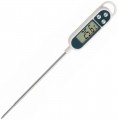Measurement range
Total allowable measurement range. The minimum / maximum temperature that the thermometer is able to fix, as a rule, is also acceptable for using the device — with further cooling / heating, malfunctions are possible up to complete failure.
Low values of this parameter are crucial for outdoor dryer models. Additionally, the inherent "margin of safety" in measuring systems often results in finding sub-zero temperatures in purely indoor models. This feature can be practical, such as assessing conditions in an unheated room during winter.
Most contemporary household thermometers boast a maximum temperature range of 50 — 60 °C, sufficient for even relatively hot climates. However, there are less heat-resistant models with temperatures ranging from 30 — 40 °C. Thermometers designed for water applications have a lower maximum temperature, as it is not necessary for their intended use. Sauna thermometers typically exhibit the highest temperature resistance.
More features
—
Display backlight. The backlight feature enables reading the display in low light or darkness. Typically activated by pressing a button and deactivated upon release, this design minimizes energy consumption. However, some devices may keep the backlight on continuously for decorative purposes.
—
Clock. Clocks that show the current time vary in dial type and functionality based on the thermometer type mentioned earlier. Electronic models use digital displays with added features, while mechanical thermometers typically feature traditional arrow dials. Some of these mechanical models even resemble watches with an integrated thermometer, emphasizing the thermometer aspect rather than the clock.
—
Alarm clock. Possibility of giving a sound signal at a certain time set by the user. An alarm clock can be used not only for getting up in the morning, but also for any reminders associated with a specific time — for example, as an impromptu replacement for a kitchen timer. This feature, by definition, requires a clock (see above).
—
Calendar. The presence of a calendar implies at least the display of the current date on the thermometer (day of the month, often the month, less often the year). In addition, electronic models may provide viewing the year by month. The calendar can be used not only by itself, but also fo
...r other functions — for example, fixing min / max temperature moments (see above).
— Moon calendar. This function provides a display of the current phase of the moon, and in most cases also allows you to determine the days of new moons and full moons. Auspicious moments for many types of human activities (cosmetic procedures, treatment, gardening) are directly dependent on the phases of the moon. This feature assumes a regular calendar (see above).
— Synchronization with smartphone. The ability to remotely connect to the device using a mobile phone (tablet) allows you to remotely monitor weather conditions and read all information from sensors.Material
The main material used in the construction of the thermometer body.
—
Plastic. Plastic, a cost-effective and highly practical material, offers versatility in shape and color. It is water-resistant, tolerant to temperature extremes, lightweight, and generally resilient enough for everyday use, even enduring falls and mishaps. This makes plastic suitable for a wide range of applications, from vibrant water thermometers for kids to discreetly designed classic devices. However, it's not ideal for saunas due to its sensitivity to high temperatures.
—
Metal. Premium and designer household thermometers typically feature metal cases, though exceptions exist. Despite being more expensive than plastic, metal's primary practical advantage lies in its high strength, which is often unnecessary for thermometers. However, metal is chosen to enhance the device's appearance, giving it a solid and luxurious look.
—
Wood. Similar to metal, wood is commonly used in designer household thermometers that prioritize both functionality and a stylish aesthetic. These devices often embrace a "retro" style, contrasting with the modern appeal of metal. Notably, wood finds optimal practical use in sauna thermometers, as it tolerates high temperatures without damage or emitting harmful substances.
— Glass. Glass is valued for its transparency but is hindered
...by fragility. Modern thermometers rarely feature all-glass cases; instead, glass is often combined with overlays of metal, plastic, or wood, with exceptions existing. It serves both practical and aesthetic purposes. For instance, glass is advantageous in outdoor and soil liquid thermometers, allowing easy scale readings. In mechanical models, it contributes to an original appearance.
